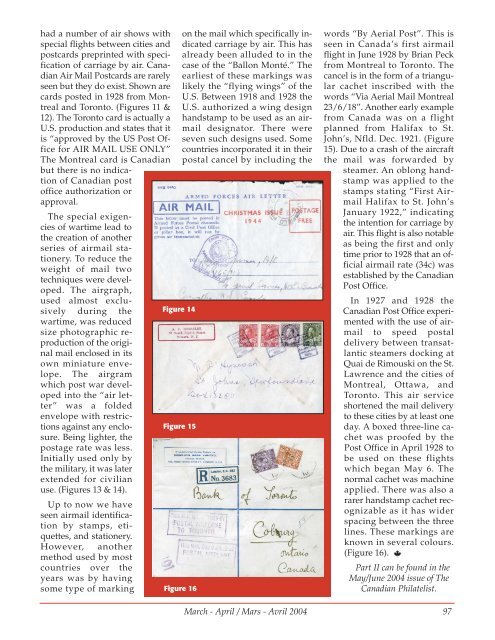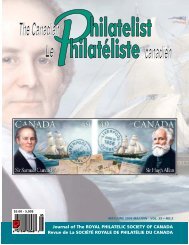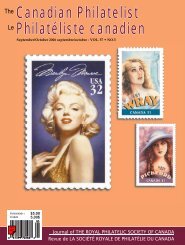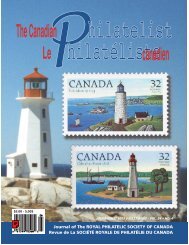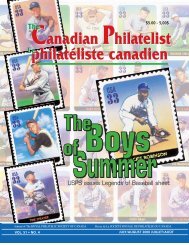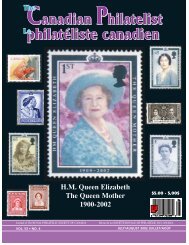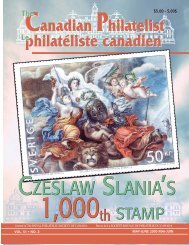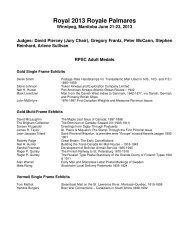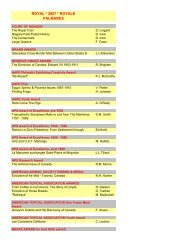ROYAL*2004*ROYALE - The Royal Philatelic Society of Canada
ROYAL*2004*ROYALE - The Royal Philatelic Society of Canada
ROYAL*2004*ROYALE - The Royal Philatelic Society of Canada
Create successful ePaper yourself
Turn your PDF publications into a flip-book with our unique Google optimized e-Paper software.
had a number <strong>of</strong> air shows with<br />
special flights between cities and<br />
postcards preprinted with specification<br />
<strong>of</strong> carriage by air. Canadian<br />
Air Mail Postcards are rarely<br />
seen but they do exist. Shown are<br />
cards posted in 1928 from Montreal<br />
and Toronto. (Figures 11 &<br />
12). <strong>The</strong> Toronto card is actually a<br />
U.S. production and states that it<br />
is “approved by the US Post Office<br />
for AIR MAIL USE ONLY”<br />
<strong>The</strong> Montreal card is Canadian<br />
but there is no indication<br />
<strong>of</strong> Canadian post<br />
<strong>of</strong>fice authorization or<br />
approval.<br />
<strong>The</strong> special exigencies<br />
<strong>of</strong> wartime lead to<br />
the creation <strong>of</strong> another<br />
series <strong>of</strong> airmail stationery.<br />
To reduce the<br />
weight <strong>of</strong> mail two<br />
techniques were developed.<br />
<strong>The</strong> airgraph,<br />
used almost exclusively<br />
during the<br />
wartime, was reduced<br />
size photographic reproduction<br />
<strong>of</strong> the original<br />
mail enclosed in its<br />
own miniature envelope.<br />
<strong>The</strong> airgram<br />
which post war developed<br />
into the “air letter”<br />
was a folded<br />
envelope with restrictions<br />
against any enclosure.<br />
Being lighter, the<br />
postage rate was less.<br />
Initially used only by<br />
the military, it was later<br />
extended for civilian<br />
use. (Figures 13 & 14).<br />
Up to now we have<br />
seen airmail identification<br />
by stamps, etiquettes,<br />
and stationery.<br />
However, another<br />
method used by most<br />
countries over the<br />
years was by having<br />
some type <strong>of</strong> marking<br />
Figure 14<br />
Figure 15<br />
Figure 16<br />
on the mail which specifically indicated<br />
carriage by air. This has<br />
already been alluded to in the<br />
case <strong>of</strong> the “Ballon Monté.” <strong>The</strong><br />
earliest <strong>of</strong> these markings was<br />
likely the “flying wings” <strong>of</strong> the<br />
U.S. Between 1918 and 1928 the<br />
U.S. authorized a wing design<br />
handstamp to be used as an airmail<br />
designator. <strong>The</strong>re were<br />
seven such designs used. Some<br />
countries incorporated it in their<br />
postal cancel by including the<br />
words “By Aerial Post”. This is<br />
seen in <strong>Canada</strong>’s first airmail<br />
flight in June 1928 by Brian Peck<br />
from Montreal to Toronto. <strong>The</strong><br />
cancel is in the form <strong>of</strong> a triangular<br />
cachet inscribed with the<br />
words “Via Aerial Mail Montreal<br />
23/6/18”. Another early example<br />
from <strong>Canada</strong> was on a flight<br />
planned from Halifax to St.<br />
John’s, Nfld. Dec. 1921. (Figure<br />
15). Due to a crash <strong>of</strong> the aircraft<br />
the mail was forwarded by<br />
steamer. An oblong handstamp<br />
was applied to the<br />
stamps stating “First Airmail<br />
Halifax to St. John’s<br />
January 1922,” indicating<br />
the intention for carriage by<br />
air. This flight is also notable<br />
as being the first and only<br />
time prior to 1928 that an <strong>of</strong>ficial<br />
airmail rate (34c) was<br />
established by the Canadian<br />
Post Office.<br />
In 1927 and 1928 the<br />
Canadian Post Office experimented<br />
with the use <strong>of</strong> airmail<br />
to speed postal<br />
delivery between transatlantic<br />
steamers docking at<br />
Quai de Rimouski on the St.<br />
Lawrence and the cities <strong>of</strong><br />
Montreal, Ottawa, and<br />
Toronto. This air service<br />
shortened the mail delivery<br />
to these cities by at least one<br />
day. A boxed three-line cachet<br />
was pro<strong>of</strong>ed by the<br />
Post Office in April 1928 to<br />
be used on these flights<br />
which began May 6. <strong>The</strong><br />
normal cachet was machine<br />
applied. <strong>The</strong>re was also a<br />
rarer handstamp cachet recognizable<br />
as it has wider<br />
spacing between the three<br />
lines. <strong>The</strong>se markings are<br />
known in several colours.<br />
(Figure 16). <br />
Part II can be found in the<br />
May/June 2004 issue <strong>of</strong> <strong>The</strong><br />
Canadian Philatelist.<br />
March - April / Mars - Avril 2004 97


